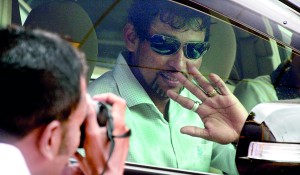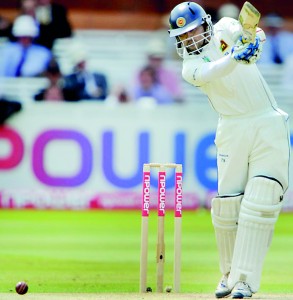Dilshan bids adieu to shirt No 79
The world of cricket will still be lucky to see his bat explode in the shorter formats, clad in the Kerry Packer’s innovation of coloured clothing, but T.M. Dilshan stepped down from Test cricket never to return.
The No.79 Sri Lankan Test cap, the country’s most senior in the current players’ list, even ahead of Mahela Jayawardene and Kumar Sangakkara, told a packed Sri Lanka Cricket (SLC) auditorium with reporters on Thursday that he had to make this move in order to help Sri Lanka explore the potential replacement, even though that choice would not be another him.

Thank you for all the support. Dilshan salutes the press. Pic by Amila Gamage
“I should retire at some point. I had a target to reach 5000 Test runs and I made it, I captained the side though I never anticipated the leadership. And when the time is right, we should step down and give the youngsters the opportunity. We are here because our ‘big brothers’ paved the way and I think today it’s our duty as seniors or ‘big brothers’ to pave the way for the youngsters,” Dilshan stated, ending his 14-year Test career, which had many ups and downs but not the word quit until last Thursday.
Dilshan, who will celebrate his 37th birthday tomorrow, earned the reputation as a solid opening batsman after he was elevated to the position of opening batsman in 2009 in all three formats of the game. He is also the signatory of the Dilscoop (The stroke made on one knee to a good length or slightly short of length delivery off a fast or medium paced bowler and scoop the ball over the head of the wicket keeper).
But Dilshan never dared to attempt that shot in Tests, perhaps due to the respect he had for the longer version of the game and stated that his decision to retire from Test cricket is solely based on the country’s interest.
“I could have easily played another two to three years in all formats, but when I, Kumar (Sangakkara) and Mahela (Jayawardene) retire at the same period it will clearly create a huge vacuum in the team, especially in the top order. I made this decision to prevent that space. This will give the team the time to explore and groom the perfect replacement while the other two seniors are still around,” Dilshan, a veteran of 87 Tests stated.
“I liked performing the role of an opening batsman for Sri Lanka which I did with a lot of pride. That was perhaps the turning point of my career. I really enjoyed every bit of my career, not only as an opener and in all three formats but I must admit that it’s not easy to

Dilshan’s iconic drive
play Tests. One must prove to be a matured cricketer to become a Test cricketer,” Dilshan elaborated.
But after his promotion as the opening batsman of Sri Lanka in all formats, Dilshan, mainly in Tests put a complete end to his average mode of batting, to become one of the destructive openers in modern day cricket.
“During the past three to four years as an opener I was able to accelerate and become a bit more explosive than my partner in the middle. One of the openers should be aggressive or else the bowlers will capitalize. I suppose it helped the team to achieve more wins in Tests. Today if you take any Test playing team, there is one opener who plays aggressively and that has become the standard nowadays,” he stated.
Dilshan not only gives much pride to Sri Lanka but to his hometown of Kalutara. It was in 1987 that Dilshan was spotted by his junior cricket coach, Sunil Saluwadana at Kalutara Vidyalaya, as a ten-year-old when he used to play cricket with his friends with a makeshift piece of wood as a bat during school hours. Saluwadana, who still continues coach Dilshan’s school team, even after nearly 25 years, revealed that Dilshan was a gifted young boy who was good at almost everything.“He was a good football player before I invited him for cricket practices. He would have been between 10 or 11 at that time and I told him that I had the gut feeling that a bright future awaits him. He turned up for practices without hesitance. Dilshan is a character who can take up any challenge. This much I know about him since he was an 11-year-old kid,” revealed Saluwadana who also stated that Dilshan picked up the game quickly to become a leading figure among juniors.
At a very early age Dilshan had replaced the regular wicketkeeper of the Kalutara Vidyalaya first XI team and held on to the position for many years. But as Saluwadana recollected Dilshan had a big target. But the setback had been his family background. Dilshan was the elder of two brothers and two sisters who came from a simple middle class family of six. His father was a sergeant of Sri Lanka Police who played top level football and the family survived on his income alone. Despite financial problems his parents were very keen followers of Dilshan and his brother T.N. Sampath who continues to play first class cricket in Sri Lanka. His progress to the top was further elaborated by Ranjan Paranavithana, who was the First XI coach when Dilshan was representing his school’s Under-15 side.
“He was still an Under-15 player when I picked him to play his debut First XI game against St. Anne’s College Kurunegala. In that match he was the last man in the batting order and we were 390 for nine wickets when he walked in to bat. I gave him the challenge to help the team reach 400 runs and he did it, proving he has the courage,” Paranavithana, presently a top class coach and a critic of the game revealed.
“Then in 1999 when I coached Sebastianites Sports Club he scored 1000 runs. I remember in the same season because of him Sebastianites won the game against NCC. NCC had a long list of left-handers and we gave him the new ball to bowl his off-spinners. He took the challenge and proved a point by taking four wickets.”
“That was the same year he was picked to the national side. He underwent a lot of pressure, because he came from an outstation school but never bowed down to any of those. There are many talented cricketers from the outstations, but Dilshan is a special character, never ready to quit. I think that specialty was his plus point which helped him become who he is at present. He is a self-learner and created two strokes unique to him, the Dilscoop and the drive that runs down the extra cover region” said Paranavithana
comments powered by Disqus

